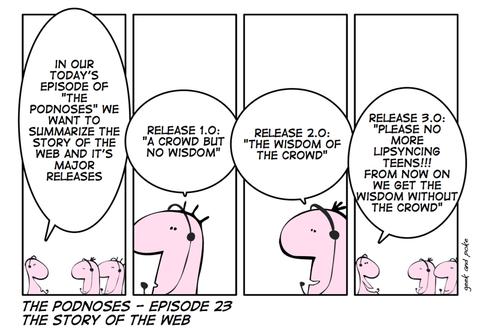Implications of Free in Education
Is Google a Noun or a Verb Anyway: The Implications of Free in Education
Free software is not only rooted in monetary policy but also in a philosophical belief that information should be free, as in liberated, and available to all who seek it. A number of different Free Culture subgroups have emerged with various interpretations on what free information should be. Some believe any for profit use of information is counter to the values of the free movement while others see a place for free existing together with fee.
"I believe that all generally useful information should be free. By 'free' I am not referring to price, but rather to the freedom to copy the information and to adapt it to one's own uses... When information is generally useful, redistributing it makes humanity wealthier no matter who is distributing and no matter who is receiving."
Richard Stallman: (source)
While the amount of information at users' finger tips explodes, budgets shrink and there is no denying the financial incentives of free – especially the free without cost part!
"The triple play of technologies – processing, storage, and bandwidth has combined to form the Web, the abundances have been compounded….there are only two numbers on the Internet: Infinity and zero…The Web has become the land of free, not because of ideology but because of economics. Price has fallen to the marginal cost, and the marginal cost of everything on line is close enough to zero that it pays to round down". – Chris Anderson (2009, Free: The Future of a Radical Price, p. 92)
Overview of Software Types
“Free” software-as in free without cost- comes in many forms. Open Educational Resources (OER) are teaching, learning and research resources in the public domain or released under intellectual property license that allows free use or repurposing. This can include full courses, course materials, software and tools to support access to knowledge. (Atkins, 2007)
Open Source Software allows developers access to the program language so that they can modify (and distribute) a product to meet their own needs. Some open source software allows users to bundle free software to create a “for-profit” product, while other categories of open source software restrict “for sale” redistribution.
Other categories of free software allow the user to “use” the software but not to change it or redistribute it. While open source software is freely available within the public domain, propriety software is software that is licensed under exclusive legal right of its owner. This can include making it available free of charge. For example, Freeware is computer software that is fully functional, available free of charge for an indefinite period of time and is either downloadable from the internet or runs on the internet. Freemium service/software is usually a basic, scaled down version of what the company offers at a premium price. Unlike Freeware, Shareware or Demoware is designed to encourage users to try out the product before buying it. The initial version may not have all the features of the full version and expires after the pre-determined trial period. Free with Advertising is the model most similar to the economic delivery model used by more traditional media. Advertisers pay for media to reach consumers, who in turn support advertisers by buying their advertised products.
Comparing the "Cost of Free"
| Software |
Pros |
Cons |
Real cost |
Implications for education |
| Open source/free software |
|
|
|
|
| Freeware |
|
|
|
|
| Shareware |
|
|
|
|
| Free with advertising models |
|
|
|
|
| Freemium |
|
|
|
|
Summary of advice for educators
Under the current financial climate it is difficult to see schools' reliance on using free software content not increasing in the near future. Therefore, it is important that educators always evaluate the product carefully before adoption or purchase. This should involve the following:
- Checking customer (especially educational users) views on, and reviews of, the product/service
- Researching and analyzing technical support levels given by the product or user community
- Constructing a well planned timeline for software implementation
- Creating of a financial plan to project both short and long term purchase costs
- Developing of an institution-wide acceptable use policy
- Ensuring adequate resources are invested in training and professional development...not just in terms of "how to" but in terms of effective use
Please see the page Evaluation Criteria and Template for Free Software to learn more about key points to consider when adopting any type of free software.
Open Knowledge and Education 
The implications of open knowledge and open access to information in education are profound. For the Generation-Y Millennials born into the digital age of social networking, sharing, remixing, mashing, creating, collaborating and posting. Students today learn from each other, and may even teach the teacher. Teachers in the future may more often play the role of guide and facilitator; therefore, selecting appropriate tools may be key.
Free and mostly free resources provide tremendous opportunities for educators and educational institutions who do their homework and make practical decisions. Today's student live digitally, and using tools that allow them to collaborate and create may improve their interest in subjects they may never have enjoyed before.Yet, all free resources are not the same nor is the definition of free as straightforward as it might appear. While most of us tend to think of free as “without cost” (gratis), others believe passionately in our unencumbered right to free (as in liberated) information.
Copyright Implications
The alternative to “free information” however, means someone or something owns it. Traditional Copyright licensing provides the means for protecting the intellectual property rights of the creator. It gives an author of original work exclusive rights to the work for a defined period of time, including its publication, distribution and adaptation, after which time the work enters the public domain.
In response to increasingly restrictive copyright legislation, free culture advocates like Lawrence Lessig (co-founder of Creative Commons) works with others in the Free Culture Movement to ensure that there are alternatives to restrictive Copyright. Creative Commons operates on the principle idea that everyone should be able to share, use, remix, and reproduce various types of sources for educational and non-educational purposes with no cost to them. Rather than restrict access to their work through rigid copyright licensing, creators can choose from a variety of Creative Commons licensing alternatives to grant copyright permissions to their works. Copyleft is a type of license that attempts to ensure that the public retains the freedom to use, modify, extend and redistribute a creative work and all derivative works (i.e., works based on or derived from it) rather than to restrict such freedoms. Understanding terms like intellectual property, public domain and fair use, instructors must model good practice and teach students current copyright regulations.
 There's No Such Thing as a Free Lunch
There's No Such Thing as a Free Lunch
Educators must be aware of the types of software they use and the real costs that are involved. Everything - even free- comes with a price. Software charges are but a minuscule portion of the total cost associated with any software implementation. Training cost, lesson planning, hardware and network costs, as well as migration and support costs typically make up the lion’s share of any project. Students and teachers can be constantly subjected to intrusive advertising. Failure to understand the limitations and permissions of the license agreement can result in a costly lawsuit. Default settings on free software often grant suppliers access to user computers and user databases. Having grown to depend on its functionality, mission critical software can unexpectedly and without notice be subjected to new user fees or disappear at the whim of the provider. Unreliable software can have catastrophic consequences at both the individual device and enterprise levels.
When considering free software and services it is wise to heed the caution in the old saying: "There's no such thing as a free lunch." Too often users confuse FREE with simplicity, low risk, and no cost. Although it might seem contradictory, FREE can be costly, and a free mistake can be costly. Just as knowing how to operate an oven does not make one a master chef, having limitless access to tools and information does not make students experts in critically evaluating the quality, limitations and risks inherent in the information, tools, license agreements, and online communities they engage with. In order to help students make informed decisions, teachers must become informed and always teach the critical thinking skills that are necessary to navigate the tangled web of today.
"Your Neighborhood: Electric circuitry has overthrown the regime of 'time' and 'space' and pours upon us instantly and continuously the concerns of all other men. It has reconstituted dialogue on a global scale. Its message is Total Change, ending psychic, social, economic and political parochialism. The old civic, state, and national groupings have become unworkable. Nothing can be further from the spirit of the new technology than 'a place for everything and everything it its place'. You can't go home again." - Marshal McLuhan
Next up: Enjoy some of Cost of Free's Best Sources of "Free" for Education

